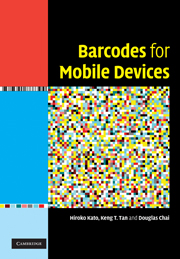Book contents
- Frontmatter
- Contents
- Preface
- 1 Introduction
- 2 Barcode technology evolution
- 3 Two-dimensional barcode for mobile phones
- 4 Evolution of barcode applications
- 5 Technologies for enhancing barcode robustness
- 6 A prototype colour 2D barcode development
- 7 Evaluation of the prototype colour 2D barcode
- Appendices
- References
- Index
- Plate section
4 - Evolution of barcode applications
Published online by Cambridge University Press: 06 July 2010
- Frontmatter
- Contents
- Preface
- 1 Introduction
- 2 Barcode technology evolution
- 3 Two-dimensional barcode for mobile phones
- 4 Evolution of barcode applications
- 5 Technologies for enhancing barcode robustness
- 6 A prototype colour 2D barcode development
- 7 Evaluation of the prototype colour 2D barcode
- Appendices
- References
- Index
- Plate section
Summary
The improvement in capability of barcode technology
Two decades have passed since the first two-dimensional (2D) barcode was introduced in 1988. Over this period, barcode technology, especially that for 2D barcodes, has evolved continuously from its original tasks for automatic identification and data capture to a tool for realising augmented reality (AR) and/or ubiquitous computing. The focus of early researchers was on the capability of 2D barcodes as a whole, in comparison with the traditional one-dimensional (1D) barcodes, and the effect of their emergence on certain sectors of industry.
Taxonomic research on 2D barcodes and a comparison with 1D barcodes
Noting the potential of this new technology, Barnes et al. [15], for example, conducted thorough taxonomic research on the 2D barcodes available at the time. They first introduced 2D barcodes in comparison with 1D barcodes and then analysed, compared and contrasted the existing 2D barcodes with each other in terms of their capability (especially data capacity and accuracy), distinctive features and applications. As a result, Barnes et al. concluded that 2D barcode technology is more advantageous than its 1D counterpart in terms of physical size, storage capability and data accuracy, despite the cost of the increase in data density. These advantageous features allow a 2D barcode to be a robust portable database, while a 1D barcode can only work as a key to access a backend database for which network connectivity must be guaranteed.
Barnes et al. [15] also referred to the trends in certain industries towards standardisation of the use of 2D barcodes that have occurred at various times.
- Type
- Chapter
- Information
- Barcodes for Mobile Devices , pp. 94 - 129Publisher: Cambridge University PressPrint publication year: 2010



